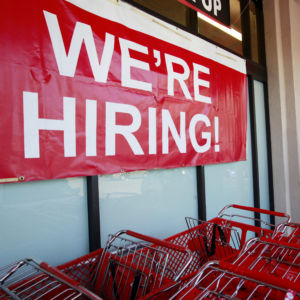The economy continues to see positive employment growth with the addition of 222,000 new jobs for the month of June, according to a federal report Friday.
The labor market has seen fairly steady employment growth over the past couple of years. The overall trend has been positive, but some lingering issues from the last recession still persist. The Bureau of Labor Statistics found in its latest jobs report that the labor market added 222,000 new jobs in June.
“Total nonfarm payroll employment increased by 222,000 in June, and the unemployment rate was little changed at 4.4 percent,” the report detailed. “Employment increased in health care, social assistance, financial activities, and mining.”
The unemployment rate has become one of the more positive labor market indicators. It currently stands close to full employment at 4.4 percent. The report highlighted jobs growth that has exceeded recent monthly averages, which appeared to have been slowing down.
The unemployment rate has slowed in recent months as the pool of working-age adults without jobs shrinks. Employment growth has averaged about 121,000 new jobs over the previous three months. The average monthly gain over the preceding 12 month period was about 194,000.
“I think from the national perspective I see a couple of good things happening,” University of North Carolina at Chapel Hill Prof. Patrick Conway told InsideSources. “In the past few years, we have seen employment growth in jobs, which is bringing people out of unemployment.”
The unemployment rate is just one measure for evaluating how the labor market is doing. The labor force participation rate, underemployment rate, productivity, and wage growth, among other indicators, can be used together to unravel other important aspects of the labor market.
“That participation rate has the room to go up several percentage points,” Johns Hopkins University economist Robert Barbera said. “The overall rate can go up a bit from here. But it doesn’t allow for robust employment growth because that’s an up that’s swinging against the down.”
The labor force participation rate tracks the number of employed or actively seeking work as a percentage of the total population. Barbera adds robust growth is unlikely since groups like student adults and retirees can account for most workforce dropouts. But there still may be some room for improvement among working age adults.
“I would be less concerned about the labor force participation rate, and more concerned about prime age working rate,” Penn State University Prof. James Tierney told InsideSources. “But that has been picking up over the past two years. That’s a positive sign.”
The labor force participation rate has at least bottomed out from its nearly decade-old free fall. The employment-population ratio for prime age adults hasn’t regained what it lost since the last recession, but it has at least made up most of the difference. Conway notes he has seen the trend firsthand in places like North Carolina.
“The labor market is performing well enough that we’re not only creating jobs for the new workers coming along, but we’re also enticing some of the existing discouraged workers, those who have not been looking for a job, to come back and start looking for jobs again,” Conway, who serves as chairman of the economics department at Chapel Hill, said.
The Great Recession was caused by the subprime mortgage crisis and the financial crisis of 2007. It was followed by an unusually prolonged recovery that is still being felt in some ways. Barbera adds the labor market is actually in good shape, but the problem is how long it took to recover from the recession.
“If you simply look at the snapshot of the last several reports, with the unemployment rate below 4.5 percent, you’d say the labor market is actually doing very well,” said Barbera, who also serves as the co-director of the Center for Financial Economics at Johns Hopkins. “It’s not just where you are, but how you got there.”
Economic downturns are often followed by a period of robust growth. In the decade since the last recession, that rapid growth did not occur. The sluggish recovery may very well account for why some trends like wages and productivity have not improved with the rest of the economy.
“In most of the other periods when you got to a very low unemployment rate, it was following an impressive growth rate,” Barbera said. “In the current circumstance, we crawled our way here.”
Barbera does note there may still be room for lawmakers to help. They could instead address the lingering issues directly like wage growth and productivity. The productivity rate stood at about 2.6 percent in the years leading up to the recession. It fell to an average of 1.2 percent in the decade since.
“You can make the case that we should do things to make productivity faster, which would allow output to grow faster without employment having to grow faster,” Barbera said. “Or you can make the case that we should try to do things that allow the jobs that are here to be higher paying, better jobs.”
A low unemployment rate often causes wages to increase with workers having more job prospects to choose from. The low unemployment rate currently has not had the same impact. The Pew Research Center found in a 2014 report that wage growth for most workers has flat-lined since 1964 when adjusted for inflation.
The low wages could also account for why some working age adults have been unwilling to reenter the labor market. The jobs report found average wages increased by four cents to $26.25 in the month of June. Increased productivity may even help wages rise as output grows.
The healthcare industry saw the most significant increase of new jobs at 37,000. It was followed by social assistance, financial activities, and mining. The jobs report does not include farm workers, private household employees, or nonprofits.

